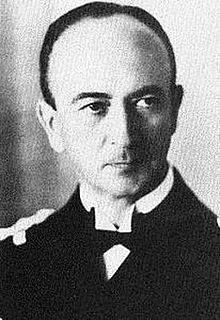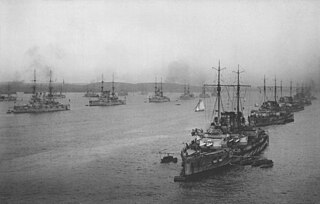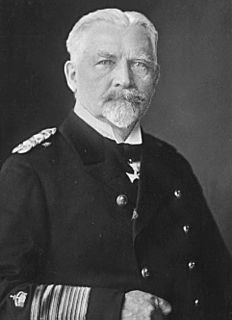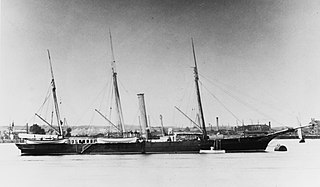
The Reichsmarine was the name of the German Navy during the Weimar Republic and first two years of Nazi Germany. It was the naval branch of the Reichswehr, existing from 1919 to 1935. In 1935, it became known as the Kriegsmarine, a branch of the Wehrmacht; a change implemented by Adolf Hitler. Many of the administrative and organizational tenets of the Reichsmarine were then carried over into the organization of the Kriegsmarine.
Ludwig von Henk was a German naval officer, who distinguished himself in the Prussian Navy and later in the Imperial German Navy of the German Empire. He retired as a Vice-Admiral.

SMS Preussen was the fourth of five pre-dreadnought battleships of the Braunschweig class, built for the German Kaiserliche Marine. She was laid down in April 1902, was launched in October 1903, and was commissioned in July 1905. Named for the state of Prussia, the ship was armed with a battery of four 28 cm (11 in) guns and had a top speed of 18 knots. Like all pre-dreadnoughts built at the turn of the century, Preussen was quickly made obsolete by the launching of the revolutionary HMS Dreadnought in 1906; as a result, she saw only limited service with the German fleet.

Eduard Karl Emanuel von Jachmann was the first Vizeadmiral of the Prussian Navy. He entered the navy in the 1840s after initially serving in the merchant marine. In 1848, Jachmann received his first command, the corvette SMS Amazone; through the 1850s and early 1860s, he held several other commands, including the frigates Thetis—aboard which he took part in the Eulenburg expedition to East Asia—and Arcona. During the Second Schleswig War in 1864, he commanded Prussian naval forces in the Baltic from Arcona, and led a small squadron at the Battle of Jasmund on 17 March. Though defeated in that battle, he was promoted to Konteradmiral for his aggressive handling of the Prussian fleet.

Conrad Albrecht was a German admiral during World War II.

The Reichsflotte was the first navy for all of Germany, established by the revolutionary German Empire to provide a naval force in the First Schleswig War against Denmark. The decision was made on 14 June 1848 by the Frankfurt Parliament, which is considered by the modern German Navy as its birthday.
Carl Eduard Heusner was a Vice-Admiral of the German Imperial Navy.

Felix von Bendemann was an Admiral of the German Imperial Navy.

SMS Danzig was a paddle corvette of the Prussian Navy. She is most notable for her role in the Battle of Tres Forcas in 1856. She was later decommissioned from the Prussian Navy and served in the navy of the Japanese Tokugawa shogunate as the Kaiten from 1864 until 1869, and then briefly with the breakaway Ezo Republic until her destruction later the same year.

SMS Amazone was the sixth member of the ten-ship Gazelle class of light cruisers that were built for the German Kaiserliche Marine in the late 1890s and early 1900s. The Gazelle class was the culmination of earlier unprotected cruiser and aviso designs, combining the best aspects of both types in what became the progenitor of all future light cruisers of the Imperial fleet. Built to be able to serve with the main German fleet and as a colonial cruiser, she was armed with a battery of ten 10.5 cm (4.1 in) guns and a top speed of 21.5 knots.

SMS Thetis was the fourth member of the ten-ship Gazelle class of light cruisers that were built for the German Kaiserliche Marine in the late 1890s and early 1900s. The Gazelle class was the culmination of earlier unprotected cruiser and aviso designs, combining the best aspects of both types in what became the progenitor of all future light cruisers of the Imperial fleet. Built to be able to serve with the main German fleet and as a colonial cruiser, she was armed with a battery of ten 10.5 cm (4.1 in) guns and a top speed of 21.5 knots.
Reinhold von Werner was a Prussian and later Imperial German naval officer in the 19th century, eventually reaching the rank of vice admiral. He commanded warships during the three wars of German Unification, the Second Schleswig War, the Austro-Prussian War, and the Franco-Prussian War in 1864, 1866, and 1870–1871, respectively, and during a naval intervention during a revolution in Spain in 1873. His actions off Spain, considered extreme by Chancellor Otto von Bismarck, resulted in his court-martial. He was promoted two years after the intervention in Spain, but was forced into retirement after a major feud with Albrecht von Stosch three years later. Werner wrote numerous books during and after his naval career, and also founded a periodical on maritime topics. He was ennobled in 1901 and died in February 1909.

Hermann Boehm was a German naval officer who rose to the rank of General Admiral during the Second World War.

The II Battle Squadron was a unit of the German High Seas Fleet before and during World War I. The squadron saw action throughout the war, including the Battle of Jutland on 31 May – 1 June 1916, where it formed the rear of the German line.

Ludwig von Schröder was a Prussian officer and Admiral during World War I and a recipient of the Pour le Mérite with Oak Leaves. Schröder entered the newly established Imperial Naval Service in May 1871. Prior to World War I, he served on several different ships and commanded the Blitz, as well as the training vessel the Moltke. He additionally functioned as the Chief of the Cruiser-Class Division in the West Indies. Von Schröder retired from active duty in 1913. One of his final assignments was as the commander of Marinestation der Ostsee.
Naval regions and districts were the official shore establishment of Nazi Germany's Kriegsmarine during World War II. The Kriegsmarine shore establishment was divided into four senior regional commands, who were in turn subordinated to the operational Navy Group commanders who commanded all sea and shore naval forces within a particular geographical region. Within each naval region were several subordinate naval districts who were responsible for all navy shore activities within their area of responsibility, most significantly were the various German ports of occupied Europe.

SMS Comet was a Camäleon-class gunboat of the Prussian Navy that was launched in 1860. A small vessel, armed with only three light guns, Comet served during the Second Schleswig War of 1864 and the Franco-Prussian War of 1870–1871, part of the conflicts that unified Germany. The ship was present at, but was only lightly engaged in the Battle of Jasmund during the Second Schleswig War. She served in a variety of roles during peacetime, including fishery protection and survey work. Comet went on one lengthy deployment abroad, with an assignment to the Mediterranean Sea from 1876 to 1879. She saw little active service after returning to Germany and was decommissioned and hulked in 1881. The vessel remained in the navy's inventory until at least 1891, being broken up sometime thereafter.
Hans Karl Meyer, was a German naval officer and Konteradmiral in the Kriegsmarine during World War II and most recently Flotilla admiral of the German Navy. Meyer was most notable for being commander of the battleship Tirpitz, of 1/Seekriegsleitung (SKL) Operations of Naval Command and being one of six Kriegsmarine admirals who were subordinated after World War II in the new German Navy.

SMS Preussischer Adler was a paddle steamer originally built in the mid-1840s for use on a packet route between the Kingdom of Prussia and the Russian Empire in the Baltic Sea. She was requisitioned by the Prussian Navy during the First Schleswig War in 1848 and converted into an aviso, the first vessel of the type commissioned by Prussia. During the war, she took part in an inconclusive action with the Danish brig St. Croix, the first naval battle of the Prussian fleet. After the war, she was disarmed and returned to her commercial role, operating uneventfully on the Stettin–St. Petersburg route until 1862, when the expansion of the Prussian Eastern Railway had rendered the maritime route superfluous. The ship was purchased by the Prussian Navy and rearmed, once again as an aviso.

SMS Grille was an aviso of the Prussian Navy built in France in the mid-1850s as part of a naval expansion program directed by Prince Adalbert of Prussia, who saw the need for a stronger fleet. She was authorized in 1855 in the aftermath of the First Schleswig War, which had demonstrated the weakness of the Prussian fleet. Grille was the first screw propeller-driven steamship to be built for Prussia; all earlier steam-powered vessels had been paddle steamers.


















